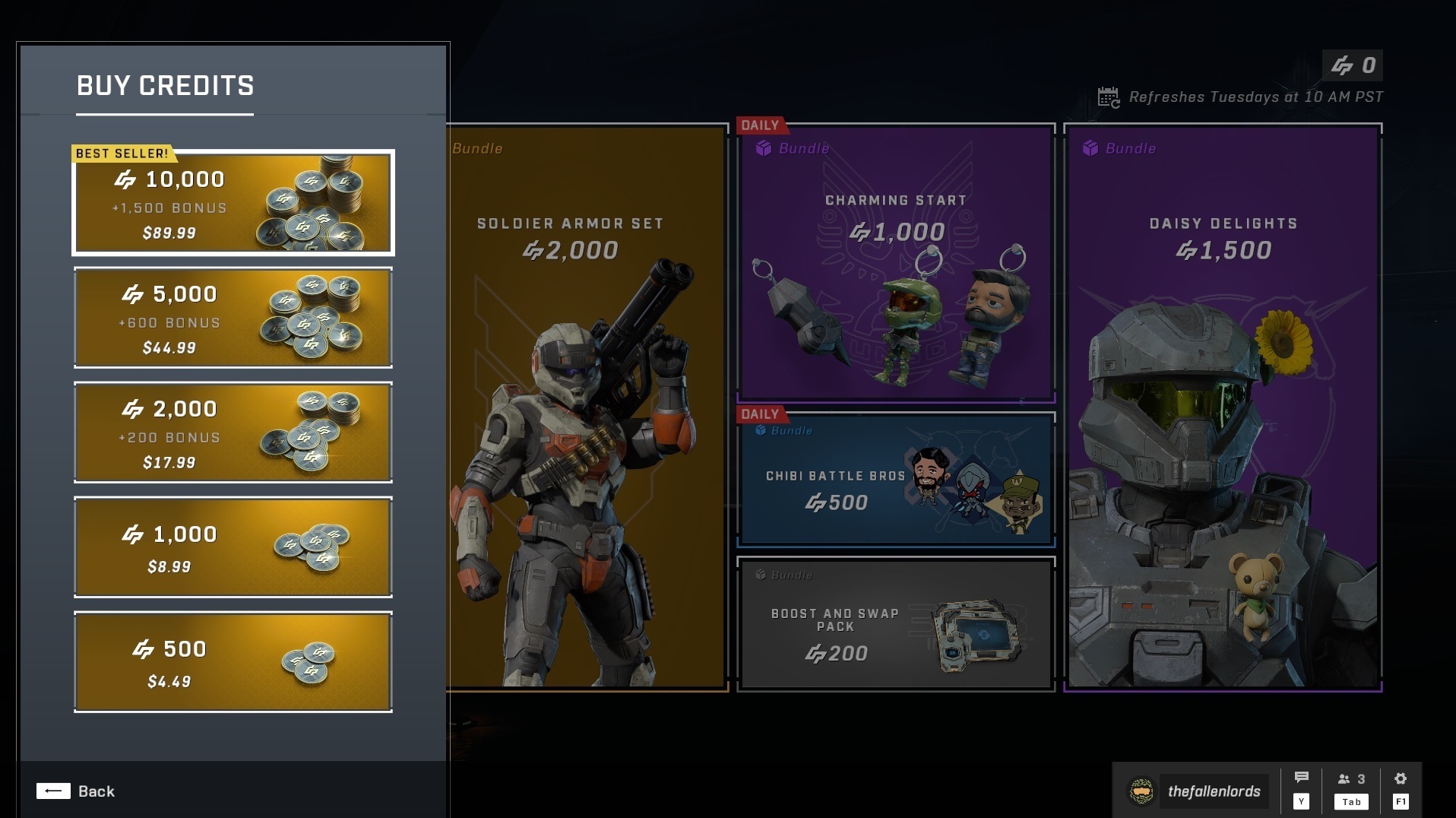After the release of two somewhat mediocre Halo games, 343 Industries seems to have finally rediscovered the formula to turn bits of code into gold with Halo Infinite. The latest entry to the Halo franchise has proven to be a fantastic game in almost every way, easily outperforming its multiplayer FPS competitors while laying the groundwork for what may very well be a decade of Halo. However, as anyone who hasn't been living under a rock would tell you, the gaming industry has changed a lot since the days that Halo reigned supreme. Standing in the way of Halo Infinite's return to long-term greatness are games like Fortnite, Apex Legends, and Call of Duty: Warzone. Then there's the internal factors, chief among them being the monetization model. Of course, it remains to be seen how 343 will decide to tackle these issues, but one can hope that they will decide to approach it in a fair and consumer-friendly manner.
To their credit, 343 and Microsoft are off to a decent start. They removed two major barriers to entry by making Halo Infinite's multiplayer free and by releasing it simultaneously on both PC and Xbox. The benefits of this cannot be stated enough as it has helped Halo Infinite gain a respectable foothold on Steam with about a quarter of a million players at its peak prior to the release of the campaign, more than double the number of Halo: The Master Chief Collection's peak numbers. For reference, this is well within range of Apex Legends' player base on Steam, which had a peak of around 330,000. The shift to free to play has also supposedly helped Halo Infinite claim the honor of being the most played game on Xbox on top of winning the fan-voted Players' Voice Award at The Game Awards.
There are multiple ways of looking at this, yet one thing is clear: Free to play was the right choice, and it will be the right choice in the future assuming that any new maps are free as well. That being said, given that the vast majority of developers don't make the player counts of their games public information, the only definitive conclusion one can make is that people haven't given up on the Halo franchise after all these years. Google Trends data supports this idea as well, with searches for Halo Infinite far outpacing those made for Call of Duty: Vanguard and Warzone and Apex Legends. Granted, it's logical for newer games to end up in search engines right after release -- though Call of Duty: Vanguard didn't enjoy the same massive search spike that Halo Infinite did, so make of that what you will.

Alas, Halo Infinite going free to play does have its downsides. To make money off of an otherwise free product, 343 implemented a battle pass system. Halo Infinite's battle pass model is fairly unassuming on the surface, filled with 100 levels of cosmetic rewards for a fairly standard price. As far as leveling goes, you can complete Challenges or simply play. The first few matches of the day grant 1000 XP in total, enough to get a full level, after which your XP gains drop to 50 XP per match until the next day. Plus 343 has stated that battle passes never expire, so you can take as long as you like to level whichever battle pass you want. It's not the greatest system in the world if you really want those cosmetics immediately, but the grind is relatively stress free compared to the likes of Call of Duty or Destiny 2. The rewards are certainly fairer as none of Halo Infinite's battle pass rewards affect gameplay.
There are two more major caveats though, assuming that all future Halo Infinite battle passes follow the same structure. The first is that if you're leveling up the free version of the battle pass, you only get a meaningful reward about once every five levels. Every level in between is filled with Challenge Swaps or nothing, which are obviously much less exciting than unlocking actual cosmetic items. The second problem lies in the fact that directly purchasing armor from the in-game store is rather expensive, with full sets being sold for up to $20 USD, with no real free-to-play alternative.
The result is that if you don't want to spend a dime on the microtransactions, you're going to have to stick with the standard armor and the basic colors for a long time, barring any campaign rewards or special events that may be going on. Generally speaking, your wallet probably isn't going to feel too much pain if you only want a specific cosmetic item set or if you only intend to purchase battle passes. However, unless you don't care about cosmetics at all, this is probably not going to encourage people to leave Fortnite or any other game where playing digital dress up and getting showered with fanfare for every little thing are as important as the gameplay itself.
Even if you put aside Halo Infinite's battle pass woes, there is an issue with the game's playlist selection, or lack thereof. As of the game's official launch, there's only a handful of game modes, and all of them are bundled under either Quick Play, Ranked, or Big Team Battle. The result is that if you want to play Capture the Flag, you must queue into any of the above playlists and hope that you are randomly assigned CTF instead of one of the other modes. To make things worse, some of the aforementioned battle pass Challenges can only be completed in certain modes. It's not as if other game modes don't exist given that Fiesta was available during the Fractures: Tenrai event. Frankly, being unable to select specific game modes isn't that big of a deal (outside of Challenges) as the core gameplay is so good, but new game modes really shouldn't be tied to events in such a manner.
Either way, playlists and game modes are going to be what makes or breaks Halo Infinite when it comes to retaining players. The steady drop in Steam player numbers outside of the Fractures: Tenrai event seems to reinforce this notion. Halo Infinite simply needs the variety as it just does not lend itself to the same kind of seemingly endless gameplay that thrive in battle royales. There are no random elements, no incredibly large map that allows for a near infinite variety of possible combat engagements, and there's almost certainly no conceivable way for 343 to implement the same kind of wacky events or crossovers that have helped Fortnite successfully target younger demographics. Not to mention the insane skill gap that genuinely new players have to overcome without the help of luck or custom loadouts.

That being said, 343 does have an ace up its sleeve. Halo Infinite is currently the only multiplayer shooter game where PvE content can help sustain the game in the long term, and with the eventual release of Forge, it is the only one where player-designed content can be a decent draw. If the publicly available player numbers on Steam are correct and representative of the audience as a whole, then having almost double the number of peak players on campaign launch compared to the previous day's peak is a good sign for PvE. Needless to say, having relatively smart AI and decently designed boss fights help a lot too. A modernized Firefight mode and or story DLC that may or may not reintroduce reworked enemy factions from previous games would certainly round out what Halo Infinite has to offer, but that's a discussion for a much later date.
Nonetheless, 343 should be proud of what they accomplished with Halo Infinite. While long-term discussions may revolve around how to maintain and grow Halo Infinite's audience, Halo Infinite as it stands now is easily one of the best of the franchise. In some ways, that's all that is needed for Halo Infinite to compete with games like Fortnite and Call of Duty: Warzone. Sure, Fortnite might remain the leader of the casual multiplayer shooter market for the foreseeable future due to the sheer number of people playing, yet history would suggest that chasing that trend is sure to end in disaster. Knocking out the trend chasers and reclaiming the competitive multiplayer crown on the other hand is quite doable (assuming that Google Trends data is indicative of anything), especially for a game whose core mechanics are as solid as Halo Infinite's.
Have a tip, or want to point out something we missed? Leave a Comment or e-mail us at tips@techraptor.net













